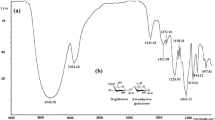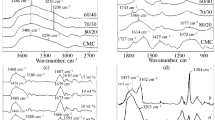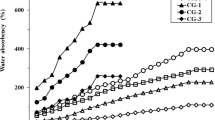Abstract
A series of κ-carrageenan (κ-CG) hydrogels were prepared by using glutaraldehyde (GA) as crosslinker for controlled releasing of copper and manganese micronutrients. The hydrogels were characterized by gel content, swelling and degradation tests, Attenuated Total Reflectance Fourier Transform Infrared Spectroscopy (ATR-FTIR) and Scanning Electron Microscope (SEM) observations. The variations of swelling percentages (S%) with time, temperature and pH were determined for all hydrogels. As the amounts of crosslinker increased, S% decreased regularly in contrast to gel content results. The higher swelling values were obtained in basic medium than acidic and neutral mediums for all κ-CG hydrogels. Releasing of copper and manganese micronutrients from κ-CG hydrogels was investigated in water and soil. A simulated releasing model was also applied to estimate the releasing behaviors in agricultural irrigations. In all release studies, the cumulative release values increased with decreasing GA amounts. The release kinetic parameters were also calculated. It was detected that the releasing of micronutrients in soil was slower than that in water.







Similar content being viewed by others
References
Shaviv A (2001) Advances in controlled-release fertilizers. Adv Agron 71:1–49
Manivasagaperumal R, Vijayarengan P, Balamurugan S, Thiyagarajan G (2011) Effect of copper on growth, dry matter yield and nutrient content of Vigna Radiata (L.) Wilczek. J Phytol 3(3):53–62
Ducic T, Polle A (2005) Transport and detoxification of manganese and copper in plants. Braz J Plant Physiol 17(1):103–112
Barker AV, Pilbeam DJ (2007) Handbook of plant nutrition. CRC Press Taylor & Francis Group, Boca Raton, pp 411–430
Bolatı I, Kara O (2017) Plant Nutrients: sources, functions, deficiencies and redundancy. J Bartin Fac For 19(1):218–228
Mahler RL (2004) Nutrients plants require for growth. University of Idaho Extension Idaho Agricultural Experiment Station, Moscow, pp 1–4
Millaleo R, Reyes-Diaz M, Ivanov AG, Mora ML, Alberdi M (2010) Manganese as essential and toxic element for plants: transport, accumulation and resistance mechanisms. J Soil Sci Plant Nutr 10(4):470–481
Azeem B, KuShaari K, Man ZB, Basit A, Thanh TH (2014) Review on materials & methods to produce controlled release coated urea fertilizer. J Control Release 181:11–21
Xie L, Liu M, Ni B, Wang Y (2012) Utilization of wheat straw for the preparation of coated controlled-release fertilizer with the function of water retention. J Agric Food Chem 60(28):6921–6928
Ji Y, Liu G, Ma J, Xu H, Yagi K (2012) Effect of controlled-release fertilizer on nitrous oxide emission from a winter wheat field. Nutr Cycl Agroecosyst 94(1):111–122
Cong Z, Yazhen S, Changwen D, Jianmin Z, Huoyan W, Xiaoqin C (2010) Evaluation of waterborne coating for controlled-release fertilizer using wurster fluidized bed. Ind Eng Chem Res 49(20):9644–9647
Pulat M, Akalin GO (2013) Preparation and characterization of gelatin hydrogel support for immobilization of Candida Rugosa lipase. Artif Cells Nanomed Biotechnol 41(3):145–151
Pulat M, Akalin GO, Karahan ND (2014) Lipase release through semi-interpenetrating polymer network hydrogels based on chitosan, acrylamide, and citraconic acid. Artif Cells Nanomed Biotechnol 42(2):121–127
Wu L, Liu M, Liang R (2008) Preparation and properties of a double-coated slow-release NPK compound fertilizer with superabsorbent and water-retention. Bioresour Technol 99(3):547–554
Shavit U, Reiss M, Shaviv A (2003) Wetting mechanisms of gel-based controlled-release fertilizers. J Control Release 88(1):71–83
Pulat M, Yoltay N (2016) Smart fertilizers: preparation and characterization of gelatin-based hydrogels for controlled release of MAP and AN fertilizers. Agrochim -Pisa Univ Press 60(4):249–261
Pulat M, Uğurlu N (2016) Preparation and characterization of biodegradable gelatin-PAAm-based IPN hydrogels for controlled release of maleic acid to improve the solubility of phosphate. Soft Mater 14(4):217–227
Popa EG, Gomes ME, Reis RL (2011) Cell delivery systems using alginate–carrageenan hydrogel beads and fibers for regenerative medicine applications. Biomacromol 12(11):3952–3961
Abad LV, Relleve LS, Aranilla CT, Rosa AMD (2003) Properties of radiation synthesized PVP-kappa carrageenan hydrogel blends. Radiat Phys Chem 68(5):901–908
Salgueiro AM, Daniel-da-Silva AL, Fateixa S, Trindade T (2012) κ-Carrageenan hydrogel nanocomposites with release behavior mediated by morphological distinct Au nanofillers. Carbohydr Polym 91(1):100–109
Daniel-da-Silva AL, Ferreira L, Gil AM, Trindade T (2011) Synthesis and swelling behavior of temperature responsive κ-carrageenan nanogels. J Colloid Interface Sci 355(2):512–517
Popa EG, Caridade SG, Mano JF, Reis RL, Gomes ME (2015) Chondrogenic potential of injectable κ-carrageenan hydrogel with encapsulated adipose stem cells for cartilage tissue-engineering applications. J Tissue Eng Regen Med 9(5):550–563
Chang C, Duan B, Cai J, Zhang L (2010) Superabsorbent hydrogels based on cellulose for smart swelling and controllable delivery. Eur Polym J 46(1):92–100
Gao X, He C, Xiao C, Zhuang X, Chen X (2013) Biodegradable pH-responsive polyacrylic acid derivative hydrogels with tunable swelling behavior for oral delivery of insulin. Polymer 54(7):1786–1793
Bao Y, Ma J, Li N (2011) Synthesis and swelling behaviors of sodium carboxymethyl cellulose-g-poly (AA-co-AM-co-AMPS)/MMT superabsorbent hydrogel. Carbohyd Polym 84(1):76–82
Wang W, Wang A (2010) Synthesis and swelling properties of pH-sensitive semi-IPN superabsorbent hydrogels based on sodium alginate-g-poly(sodium acrylate) and polyvinylpyrrolidone. Carbohyd Polym 80(4):1028–1036
Loh XJ, Peh P, Liao S, Sng C, Li J (2010) Controlled drug release from biodegradable thermoresponsive physical hydrogel nanofibers. J Control Release 143(2):175–182
Dang QF, Yan JQ, Li JJ, Cheng XJ, Liu CS, Chen XG (2011) Controlled gelation temperature, pore diameter and degradation of a highly porous chitosan-based hydrogel. Carbohyd Polym 83(1):171–178
Deshmukh M, Singh Y, Gunaseelan S, Gao D, Stein S, Sinko PJ (2010) Biodegradable poly(ethylene glycol) hydrogels based on a self-elimination degradation mechanism. Biomaterials 31(26):6675–6684
Tan R, She Z, Wang M, Fang Z, Liu Y, Feng Q (2012) Thermo-sensitive alginate-based injectable hydrogel for tissue engineering. Carbohyd Polym 87(2):1515–1521
Varghese JS, Chellappa N, Fathima NN (2014) Gelatin-carrageenan hydrogels: role of pore size distribution on drug delivery process. Colloids Surf B Biointerfaces 113:346–351
Sarkar DJ, Singh A, Mandal P, Kumar A, Parmar BS (2015) Synthesis and characterization of poly (CMC-gcl-PAam/Zeolite) superabsorbent composites for controlled delivery of zinc micronutrient: swelling and release behavior. Polym-Plast Technol 54(4):357–367
Han J, Guenier A, Salmieri S, Lacroix M (2008) Alginate and chitosan functionalization for micronutrient encapsulation. J Agric Food Chem 56:2528–2535
Ma Z, Jia X, Hu J, Liu Z, Wang H, Zhou F (2013) Mussel-inspired thermosensitive polydopamine-graft-poly(N-isopropylacrylamide) coating for controlled-release fertilizer. J Agric Food Chem 61(50):12232–12237
Jamnongkan T, Kaewpirom S (2010) Potassium release kinetics and water retention of controlled-release fertilizers based on chitosan hydrogels. J Polym Environ 18(3):413–421
Wu L, Liu M (2008) Preparation and properties of chitosan-coated NPK compound fertilizer with controlled-release and water-retention. Carbohyd Polym 72(2):240–247
Jin S, Yue G, Feng L, Han Y, Yu X, Zhang Z (2011) Preparation and properties of a coated slow-release and water-retention biuret phosphoramide fertilizer with superabsorbent. J Agric Food Chem 59(1):322–327
Distantina S, Rochmadi R, Fahrurrozi M, Wiratni W (2013) Preparation and characterization of glutaraldehyde-crosslinked kappa carrageenan hydrogel. Eng J 17(3):58–66
Akalin GO, Pulat M (2018) Preparation and characterization of nanoporous sodium carboxymethyl cellulose hydrogel beads. J Nanomater. https://doi.org/10.1155/2018/9676949
Islam A, Yasin T, Bano I, Riaz M (2012) Controlled release of aspirin from pH- sensitive chitosan/poly (vinyl alcohol) hydrogel. J Appl Polym 124(5):4184–4192
Pereira L, Amado AM, Critley AT, Van de Velde F, Ribeiro-Claro PJA (2009) Identification of selected seaweed polysaccharides (phycocolloids) by vibrational spectroscopy (FTIR-ATR and FT-Raman). Food Hydrocoll 23(7):1903–1909
Tan H, DeFail AJ, Rubin JP, Chu CR, Marra KG (2010) Novel multiarm PEG-based hydrogels for tissue engineering. J Biomed Mater Res A 92(3):979–987
Yi G, Huang Y, Xiong F, Liao B, Yang J, Chen X (2011) Preparation and swelling behaviors of rapid responsive semi-IPN NaCMC/PNIPAm hydrogels. J Wuhan Univ Technol-Mater Sci Ed 26(6):1073–1078
Hezaveh H, Muhamad II (2013) Modification and swelling kinetic study of kappa-carrageenan-based hydrogel for controlled release study. J Taiwan Inst Chem Eng 44(2):182–191
Gao X, He C, Xiao C, Zhuang X, Chen X (2012) Synthesis and characterization of biodegradable pH-sensitive poly(acrylic acid) hydrogels crosslinked by 2-hydroxyethyl methacrylate modified poly(l-glutamic acid). Mater Lett 77:74–77
Liu Z, Yang Z, Luo Y (2012) Swelling, pH sensitivity, and mechanical properties of poly(acrylamide-co-sodium methacrylate) nanocomposite hydrogels impregnated with carboxyl-functionalized. Polym Compos 33(5):665–674
Hu X, Li D, Zhou F, Gao C (2011) Biological hydrogel synthesized from hyaluronic acid, gelatin and chondroitin sulfate by click chemistry. Acta Biomater 7(4):1618–1626
Zamora-Mora V, Velasco D, Hernández R, Mijangos C, Kumacheva E (2014) Chitosan/agarose hydrogels: cooperative properties and microfluidic preparation. Carbohydr Polym 111:348–355
Jamnongkan T, Kaewpirom S (2010) Controlled-release fertilizer based on chitosan hydrogel: phosphorus release kinetics. Sci J UBU 1(1):43–50
Rudzinski WE, Chipuk T, Dave AM, Kumbar SG, Aminabhavi TM (2003) pH-sensitive acrylic-based copolymeric hydrogels for the controlled release of a pesticide and a micronutrient. J Appl Polym Sci 87:394–403
Abedi-Koupai J, Varshosaz J, Mesforoosh M, Khoshgoftarmanesh AH (2012) Controlled release of fertilizer microcapsules using ethylene vinyl acetate polymer to enhance micronutrient and water use efficiency. J Plant Nutr 35:1130–1138
Saruchi Kaith BS, Jindal R, Kapur GS (2013) Enzyme-based green approach for the synthesis of gum tragacanth and acrylic acid cross-linked hydrogel: its utilization in controlled fertilizer release and enhancement of water-holding capacity of soil. Iran Polym J 22:561–570
Li Q, Wu S, Ru T, Wang L, Xing G, Wang J (2012) Synthesis and performance of polyurethane coated urea as slow/controlled release fertilizer. J Wuhan Univ Technol-Mater Sci Ed 27(1):126–129
Singh B (2007) Psyllium as therapeutic and drug delivery agent. Int J Pharm 334(1–2):1–14
Adams C, Frantz J, Bugbee B (2013) Macro- and micronutrient-release characteristics of three polymer-coated fertilizers: Theory and measurements. J Plant Nutr Soil Sci 176(1):76–88
Tomaszewska M, Jarosiewicz A (2004) Polysulfone coating with starch addition in CRF formulation. Desalination 163(1–3):247–252
Jayakumar R, Prabaharan M, Reis RL, Mano JF (2005) Graft copolymerized chitosan—present status and applications. Carbohyd Polym 62(2):142–158
Bajpai AK, Giri A (2002) Swelling dynamics of a macromolecular hydrophilic network and evaluation of its potential for controlled release of agrochemicals. React Funct Polym 53(2–3):125–141
Sankar C, Mishra B (2003) Development and in vitro evaluation of gelatin A microspheres of Ketorolac tromethamine for intranasal administration. Acta Pharm 53:101–110
Acknowledgements
This work was financially supported by the Scientific Research Projects Coordination Unit of Gazi University (Grant No. 05/2015-08).
Author information
Authors and Affiliations
Corresponding author
Ethics declarations
Conflicts of interest
The authors declare that they have no conflicts of interest.
Additional information
Publisher's Note
Springer Nature remains neutral with regard to jurisdictional claims in published maps and institutional affiliations.
Rights and permissions
About this article
Cite this article
Akalin, G.O., Pulat, M. Preparation and characterization of κ-carrageenan hydrogel for controlled release of copper and manganese micronutrients. Polym. Bull. 77, 1359–1375 (2020). https://doi.org/10.1007/s00289-019-02800-4
Received:
Revised:
Accepted:
Published:
Issue Date:
DOI: https://doi.org/10.1007/s00289-019-02800-4




